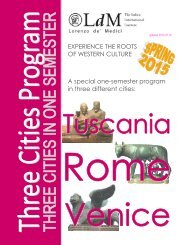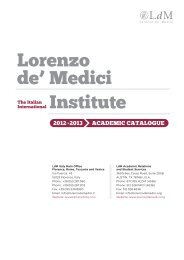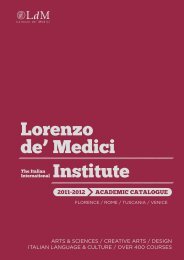aCademiC Catalog 2013-2014 - Lorenzo de Medici
aCademiC Catalog 2013-2014 - Lorenzo de Medici
aCademiC Catalog 2013-2014 - Lorenzo de Medici
You also want an ePaper? Increase the reach of your titles
YUMPU automatically turns print PDFs into web optimized ePapers that Google loves.
FLORENCE<br />
School of Arts & Sciences<br />
Anthropology<br />
Introduction to Anthropology<br />
ANT 160 F<br />
Cr: 3; Contact hrs: 45<br />
This course will introduce stu<strong>de</strong>nts to the wi<strong>de</strong> range of social<br />
and cultural diversity that exists in the world in or<strong>de</strong>r to <strong>de</strong>velop<br />
a comprehensive approach to thinking about the human<br />
condition. We will examine all aspects of human life through<br />
anthropology’s sub-fields. These inclu<strong>de</strong> cultural anthropology<br />
(the diverse ways of life, how people give meaning to their<br />
experiences), biological anthropology (the study of human<br />
evolution and adaptation), archaeology (the study of past<br />
human societies through their material remains) and linguistic<br />
anthropology (how language and symbols are used).<br />
Anthropology of Fashion and Desirability:<br />
Beyond the Catwalk<br />
ANT 185 F; Dual listed: FAS 185 F<br />
Cr: 3; Contact hrs: 45<br />
When we hear “fashion”, we think automatically of clothes and<br />
dress, but fashionability entails much more than the latest style<br />
of shoe on the catwalk. Trends of style and <strong>de</strong>sirability occur in<br />
every human society, from the most “simple” to our own highly<br />
complex international interactions. Using the fashion of dress<br />
as a starting point, this course examines the universal patterns<br />
and particular variations of fashionability in both Euro-American<br />
and non-Western societies. We will examine the phenomenon<br />
of fashion in clothing, speech, and activities by searching<br />
for trends and examining the trajectory of fashionability as<br />
practices move from the un<strong>de</strong>rground to the mainstream to<br />
being “old-fashioned”, because fashion is necessarily <strong>de</strong>fined<br />
in opposition to something that is not fashionable (is Mizrahi<br />
still cool now that he <strong>de</strong>signs for Target? Or is he even cooler?).<br />
We will investigate historic examples of past fashions, as well as<br />
current trends and the phenomenon of brand awareness, with<br />
an eye on our own sense of what makes something fashionable<br />
for us today.<br />
Anthropology of Violence and Conflict<br />
ANT 190 F; Dual listed: PST 190 F<br />
Cr: 3; Contact hrs: 45<br />
This course explores the dynamics of conflict in social relations<br />
and investigates the circumstances un<strong>de</strong>r which violence,<br />
in its different aspects, may arise, on the un<strong>de</strong>rstanding that<br />
while conflict can no doubt play a positive role in social life, by<br />
no means the same can be said of violence. The first part of<br />
the course will <strong>de</strong>al with conflict and violence at the “micro”<br />
level - that is with conflict and, occasionally, violence among<br />
individuals in everyday social relations - and specifically with<br />
the role played by the pragmatic dimension in conflictual<br />
interactions. The second part of the course will <strong>de</strong>al with conflict<br />
at the “macro” level - that is conflict between large groups -<br />
focusing especially on the investigation of the circumstances<br />
un<strong>de</strong>r which conflict is likely to erupt into macro-scale violence.<br />
In this light, the concept of ethnic i<strong>de</strong>ntity shall be analyzed,<br />
and the notion of ethnic conflict – with examples from Africa,<br />
Asia, and the Balkans, illustrated with the aid of documentary<br />
films – will be put un<strong>de</strong>r scrutiny.<br />
Archaeology Workshop<br />
ANT 193 F; Dual listed: CLA 193 F / RES 193 F<br />
Cr: 3; Contact hrs: 45<br />
This course combines an introduction to archaeology with<br />
hands-on work on 2500 year-old archaeological finds in LdM’s<br />
Archaeology Lab. These finds have recently been unearthed<br />
in central Italy in the archaic settlement of Accesa, un<strong>de</strong>r the<br />
scientific direction of the University of Florence, and in the<br />
Hellenistic necropolis of Bosco <strong>de</strong>lla Riserva, near Tuscania,<br />
where an excavation project is being conducted by LdM<br />
Stu<strong>de</strong>nts will learn what happens to the finds once they leave<br />
their recovery contexts and arrive in Florence: here, un<strong>de</strong>r the<br />
expert guidance of the instructors, stu<strong>de</strong>nts will be involved<br />
in the fundamental activities of restoration, conservation,<br />
documentation,study and storage of the finds. This course<br />
will also give stu<strong>de</strong>nts a general survey of the evolution of the<br />
discipline of archaeology over time and it will introduce them to<br />
the ancient Etruscan civilization, which forms such an important<br />
part of Italy’s culture and heritage. Stu<strong>de</strong>nts will also have the<br />
opportunity to sign up to the summer workshop in Tuscania<br />
which operates directly at one of the archaeological sites.<br />
Food and Culture<br />
ANT 198 F; Dual listed: CLT 198 F / NUH 198 F<br />
Cr: 3; Contact hrs: 45<br />
If “you are what you eat”, just why do you eat the way you do?<br />
This course consi<strong>de</strong>rs the relationships between the multiple<br />
meanings of food and the acts of preparing and eating food,<br />
and further explores food and personal and social i<strong>de</strong>ntity.<br />
Stu<strong>de</strong>nts will examine why different people make different food<br />
choices in their daily lives, why individuals from certain social<br />
classes will avoid or esteem particular foods, and in general how<br />
food serves as a factor in self-<strong>de</strong>finition. Because a person’s<br />
attitu<strong>de</strong> toward food can reveal not just personal i<strong>de</strong>ntity traits<br />
but a whole food i<strong>de</strong>ology, this course will also analyze the role<br />
of food in the construction of ethnic i<strong>de</strong>ntity, in the display of<br />
religious beliefs, and in the negotiation of gen<strong>de</strong>r roles. Stu<strong>de</strong>nts<br />
learn how cultures and values are transmitted and preserved<br />
through food. Through personal essays and the interdisciplinary<br />
secondary literature, stu<strong>de</strong>nts will be gui<strong>de</strong>d to analyze the<br />
complex and fascinating relationships between people and<br />
food, helping them to un<strong>de</strong>rstand how cultures (including their<br />
own) ultimately <strong>de</strong>termine all human food choices.<br />
Anthropology and Development<br />
ANT 200 F; Dual listed: PST 200 F<br />
Cr: 3; Contact hrs: 45<br />
The course provi<strong>de</strong>s an up-to-date and in-<strong>de</strong>pth un<strong>de</strong>rstanding<br />
of anthropological perspectives on policy and practice in<br />
contemporary international <strong>de</strong>velopment aid, and gives a<br />
theoretical overview of the relationship between <strong>de</strong>velopment<br />
aid and anthropology. Stu<strong>de</strong>nts explore the contribution of<br />
anthropology to contemporary <strong>de</strong>velopment aid <strong>de</strong>bates, on<br />
poverty, human rights, violence and complex emergencies, and<br />
the “market” as a core metaphor of globalized <strong>de</strong>velopment.<br />
The politics of humanitarian aid, shifting aid frameworks, and<br />
concrete intervention programs in <strong>de</strong>veloping countries will<br />
be examined, bridging the disparate worlds of planners of<br />
international agencies and beneficiaries of poor countries.<br />
Concepts and <strong>de</strong>bates are then probed further through<br />
examination of real study cases of <strong>de</strong>velopment projects in<br />
Africa and South America, with the contribution of international<br />
consultants working in the sector of humanitarian aid and<br />
<strong>de</strong>velopment cooperation. Simulations of “participatory<br />
methods” will be also inclu<strong>de</strong>d as a manner of exploring the<br />
meaning of the key concepts of community <strong>de</strong>velopment,<br />
popular “participation” and “empowerment.”<br />
Archaeology of Religion: Death and Ritual in<br />
the Past<br />
ANT 252 F; Dual listed: CLA 252 F / PHR 252 F<br />
Cr: 3; Contact hrs: 45<br />
Religion is based on a combined system of beliefs and practices<br />
that allows people to answer fundamental questions regarding<br />
human life. What can archaeology tell us about religion? The<br />
course explores key questions regarding the role and evolution<br />
of religious beliefs and practices by systematically analyzing<br />
the archaeological remains of ancient religious material culture<br />
across the Mediterranean and the Ancient Near East, between<br />
the prehistoric and early classical periods. Direct links between<br />
religious practices and beliefs are strongly evi<strong>de</strong>nt in ancient<br />
societies, where the construction of large physical structures<br />
(such as temples) appears to be pivotal in the evolution<br />
of mankind. Stu<strong>de</strong>nts learn to use archaeological data and<br />
historical sources for the period. They address broad theoretical<br />
and methodological issues, explore how architecture was used<br />
by ancient societies in creating their cosmological landscape,<br />
and evaluate interpretations of the first appearance of family<br />
ancestor cults. The first part of the course treats theoretical<br />
and methodological issues in the study of religious thought,<br />
while the second part reinforces un<strong>de</strong>rstanding through close<br />
analysis of ancient written sources, architecture, and other<br />
examples of material culture.<br />
Prerequisites: one previous course in History of Religions,<br />
Cultural Anthropology, Archaeology<br />
48<br />
LdM Aca<strong>de</strong>mic <strong>Catalog</strong> <strong>2013</strong>-<strong>2014</strong>





